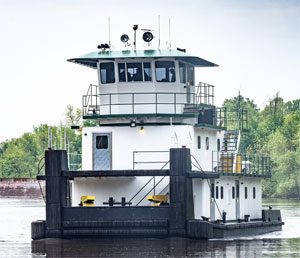Springtime on the Kaskaskia River saw a smothering flood of water and the delivery of a new pushboat for Southern Illinois Transfer (SIT).
Barbour JB Shipyard, an SIT partner company on the Kaskaskia at Baldwin, Ill., built the 68-by-28-foot Karl E. Johnson. The 1,500-hp harbor tug has propulsion from twin Tier 3 Cummins diesels. As of mid-May, it was undergoing final outfitting.
Several design and machinery variations distinguish Karl E. Johnson from most towboats plying U.S. inland waterways. One is the double-chine Barbour hull. Another is the first installation of Veth z-drive propulsion on a new Midwest towboat. But first, a little history to explain the path that led to these characteristics.
Southern Illinois Transfer was founded by the Brown family in 1961 as a harbor service company in St. Genevieve, Mo. In 1974, the Kaskaskia River opened for navigation from the Mississippi River to mile marker 35 at Fayetteville, Ill. The Browns partnered with Kaskaskia Regional Port District (KRPD) to operate terminals at KRPD 2 (mile marker 18.5) at Baldwin, Ill., and KRPD 1 (mile marker 24.5) at New Athens.
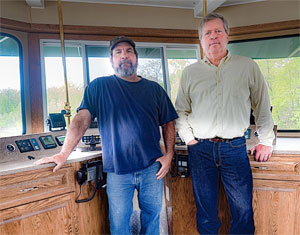 |
|
SIT President Kurt Johnson, right, standing with port captain Bob Kisro. |
“We bought the company in 2007 with five boats,” said Kurt Johnson, SIT president and part owner with Michael Howe and the brothers Mark and Ronald Arbeiter. Since then, the firm added six boats, including Karl E. Johnson, named for Kurt’s brother, who passed away in 2011.
“We started looking at new boats in 2013, and my first bid gave me sticker shock,” Johnson recalled. “I realized that there are not that many tons of steel in a towboat, so I thought we could build our own.”
In 2013, Southern Illinois Transfer joined with George Foster’s company, JB Marine Service, to form Barbour JB Shipyard. The shipyard is located on the KRPD 2 site. The Barbour in the shipyard name is derived from Kenny Barbour’s double-chine towboat hull design. Foster bought his company in the late 1970s.
Karl E. Johnson, designed by SIT with engineering by Sterling Marine, is the third boat the shipyard built with a Barbour hull. The yard sold the first boat, but the 68-foot Kaskaskia Warrior — completed in early 2019 — joined the SIT fleet.
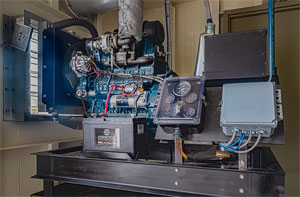 |
|
Electrical power aboard Karl E. Johnson comes from two 40-kW Kubota gensets located on the main deck. |
The conventionally propelled Kaskaskia Warrior proved the efficiency of the Barbour hull, providing better water flow to the propellers and 20 percent more thrust, Johnson said. The vessel can push a four-barge tow about 50 percent faster on about one-third less fuel than other boats in the fleet.
“We call it Barbour hull voodoo,” Johnson said. “The engineers can’t explain why it pushes so well, but it does. What our people tell us is that our 1,500-hp boat handles and pushes like an 1,800-hp boat.”
Although z-drives are becoming more common on U.S. towboats, the vast majority of new inland vessels still have conventional propulsion. Johnson admitted concerns about installing z-drives on Karl E. Johnson, but a little research and the firm’s history with Twin Disc both were reassuring. “We had confidence,” Johnson said, “that Twin Disc would not sell us a product that wouldn’t perform.”
The Veth drives are powered by two 750-hp Cummins QSK19 mains painted Cummins corporate red — a bold departure from Cummins’ standard off-white pigment. “I was watching ‘Deadliest Catch’ and they had a red engine,” Johnson said. “I thought, ‘Why can’t we have one, too?’”
SIT intentionally stayed within Tier 3 for its new engines. The benefits of avoiding Tier 4 are obvious by now: They include maintenance, cost and space required for the diesel exhaust fluid (DEF) aftertreatment and tankage. Moving to Tier 4, Johnson said, would have doubled the cost of the vessel and significantly increased maintenance.
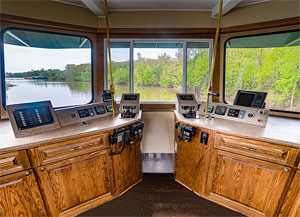 |
|
Karl E. Johnson’s wheelhouse is equipped with Furuno navigation gear. |
Two Kubota 40-kW, radiator-cooled generators are another departure from convention. They are housed on the main deck, rather than in the engine room, and are vented to the outside through shuttered voids in the superstructure.
The double chine on a Barbour hull, shallow though it is, robs space lower in the hull that would normally house keel coolers servicing the main engines and generators. Also, to keep the coolers submerged because of the water trough created on the beam by the hull form, it is necessary to get them as low on the hull as possible. The solution was to install narrower keel coolers and to have an autonomous generator setup. The configuration also provides more space in the engine room.
The grating material fitted throughout the machinery and outside deck area is also unique. The fiberglass grates are easier to maintain, lighter for crew to handle and easier to replace, Johnson said. They’re also less prone to vibration.
Another nod to crew comfort and the reduction of vibration is the incorporation of Christie & Grey isolation mounts. “There is virtually no vibration throughout the boat,” Johnson said.
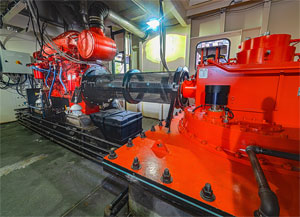 |
|
Twin Cummins 750-hp QSK19 engines turn Veth VZ-700 z-drives aboard the 68-foot Karl E. Johnson. |
Karl E. Johnson brings the Southern Illinois Transfer fleet to nine towboats working on the Mississippi and Kaskaskia rivers. In addition to barge terminals at KRPD 1 and 2, SIT operates harbor services for a Mississippi Lime Company dock and Kellogg Dock at St. Genevieve. The products transported include slag, fertilizer, limestone, steel coils, frac sand and coal. Recently the company expanded to the Upper Mississippi, with operations at mile marker 120 in the New Bourbon region of Missouri.
“The next boat we build will be a retractable-house version of the Karl E. Johnson, able to get under the bridges on the Kaskaskia at high water,” said Johnson.
He recognizes being able to build boats in house, on spec, is a luxury. But it also harbors conflict. Should the company keep the boat or sell it?
“We are always looking to sell boats to other customers, but we need three more for ourselves,” he said. “The efficiency of the Barbour hull and the z-drives makes it hard for me as a harbor services operator to sell the boats. But as the owner of a shipyard — that’s the tension between my operator’s hat and my shipyard hat.”

